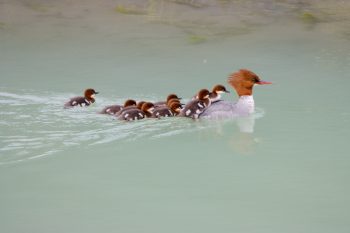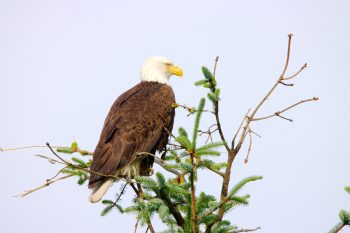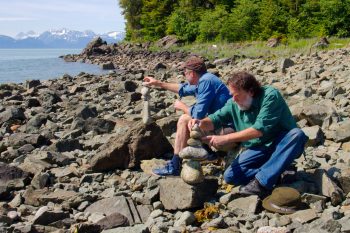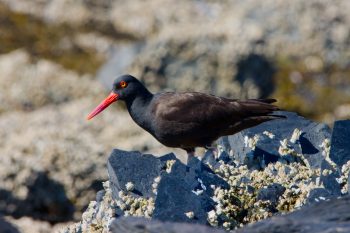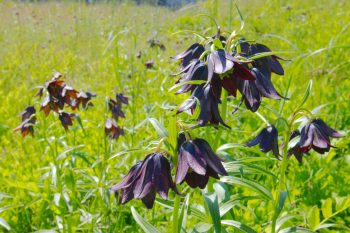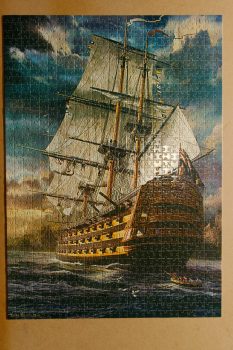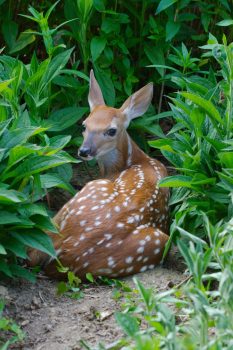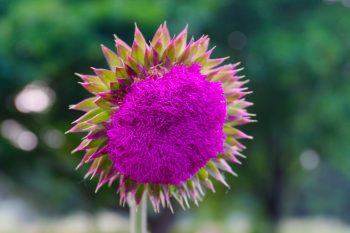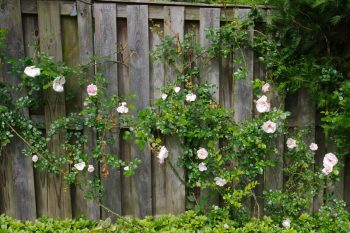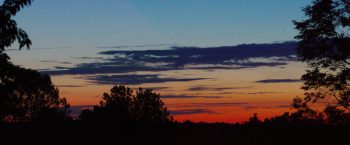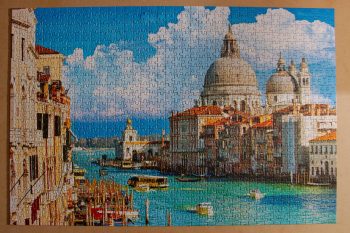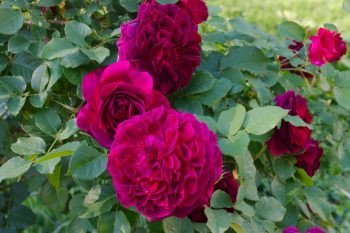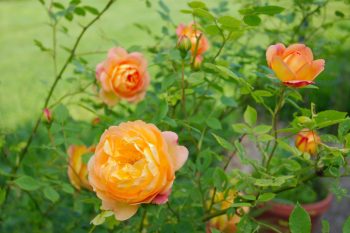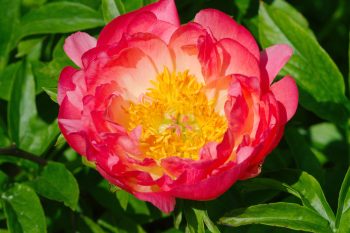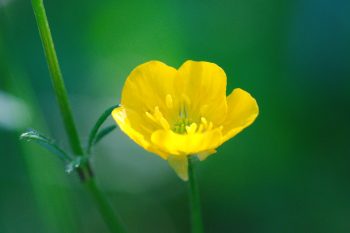Cathy and I went to the glacier this afternoon. By ‘the glacier’ I mean the Mendenhall. We had been in the valley at a cemetery looking for the grave of one of Cathy’s mom’s siblings (we found it) and since we were close, we decided to head to the glacier and see what we could see. It was mostly cloudy, but not raining and still quite pretty. There are arctic terns (Sterna paradisaea) nesting on the shore of Mendenhall Lake and I was able to get a few decent photos of them. But my favorite is this one of a common merganser (Mergus merganser) with ducklings on its back and following it along. There were ten ducklings in all, although you can only see nine in this photo.
Common Merganser and Ducklings (Mergus merganser)
Bald Eagle (Haliaeetus leucocephalus)
After breakfast and some time writing in my journal this morning I decided to see if I could get some pictures of eagles. I know the people living in Juneau are so used to them that they don’t even notice them much of the time. We have a pair nesting less than a mile from our house (as the eagle flies) but we’re still excited to see them. When trying to decide what to bring on this trip, I was determined to bring my new 150-600mm zoom lens. I had to rearrange my camera bag and leave a few other things out, but I’m glad I brought it. Today was my first opportunity to get a really good view. There was a large dirt pile, probably 25 or 30 feet high, behind a gas station and in the tree tops beyond that were eagles. My presence made a few of them nervous and a couple flew away, but others, including this handsome bird, stayed and let me get some really nice photos.
Rock Balancing
As you might guess, although I take most of the pictures with my camera, Cathy took this shot. We had driven to the end of the road and then walked to the shore just past Echo Cove. This is as far as you can drive from downtown Juneau. It was sunny and hot, which is unusual for Juneau, but we enjoyed being out. Cathy and Lisa were down near the water and Brian and I sat higher on the rocky beach and started balancing stones. It’s a fiddly thing but soothing in its own way. We each managed to get a respectable cairn built and Cathy took a few pictures as we worked on our final stones. The horse flies started to bother us, so we headed back to the car and back to town for the evening.
Black Oystercatcher (Haematopus bachmani)
On our second morning in Juneau we walked to False Outer Point. There is a causeway to Shaman Island that is walkable during exceptionally low tied and we happened to come when it was above water. We calculated that we had about a half hour before the water would rise to the top of the causeway. As it turns out, we miscalculated by about ten minutes and we had to wad back in about four inches of water. But we didn’t mind. We didn’t really get to explore the island very well in the 25 minutes we were there, but we did see a pair of black oystercatchers (Haematopus bachmani), which was a real treat. One was standing on one foot on top of a rock. The other one (this one) was moving around, presumable finding things to eat. The rocks around the island are covered with mussels, which is a large part of an oystercatcher’s diet, so it makes perfect sense that we’d see the here if we were going to see them at all. Am I glad yet that I brought my long lens? Yes, yes I am.
Chocolate Lily (Fritillaria camschatcensis)
We came to Juneau expecting rain. The weather for the last few weeks has been rain for about six days out of every seven. We woke up this morning to a clear, blue sky. After breakfast, we headed out with Brian, Lisa, and the dogs to the airport flats. This is the delta of the Mendenhall River, which has basically silted up most of the channel separating Douglas Island from the mainland. There is still a small channel that’s still got water in it, even at low tide, although an annual ‘Mud Run’ crosses the channel, so it’s not terribly deep. The flats are a good place to walk the dogs and we enjoyed being out. I got a nice photo of a savannah sparrow (Passerculus sandwichensis) and we saw lots of lupine as well as many chocolate lilies (Fritillaria camschatcensis). They are pretty, in a brown sort of way, although I can’t recommend their fragrance, in particular. They are native to eastern Asia, Alaska, Yukon Territory, British Columbia and the far northwestern contiguous United States.
Sea–Tac Airport
A few months ago Cathy and I bought tickets to fly to Juneau, Alaska. The plan was to leave here on June 17 and return July 3, allowing us to have a free day on July 4 to recover before returning to work on July 6.
Our outbound flight left Dulles Airport at 5:00 PM and we had an uneventful five and a half hour flight to Sea-Tac (Seattle–Tacoma International Airport). As is often the case on travel days, I didn’t take many photographs. I don’t think I’ll be giving too much away when I say that I took almost 2,500 photos during our trip, however, so the posts following this one will give you a very brief glimpse of what we saw and did.
Ship Puzzle
It’s time for another installment of Henry and Cathy’s puzzle collection. This one looked nice so I bought it and we finished putting it together a couple days ago. The water in the foreground and the sky were the most challenging parts, which isn’t too surprising. The stern of the ship and parts of the rigging were done first (after the edges, of course, which are almost always finished before much else has been done.
We don’t absolutely always have a puzzle going, but lately we’ve tried to. We’re running out of them, though, with only a few more on hand, so I’m not sure what we’ll do after that. We also like crossword puzzles, sometimes doing them together but more often, separately. We have crossword puzzle books, published by Simon and Schuster and The New York Times. For quite a while now, my mom has saved the puzzles from the Washington Post and gives them to me, so I work through those. They are generally a bit easier than the other two sources and I actually do them in pen (and sometimes without actually making mistakes, although certainly not all the time).
Eastern White-tailed Deer Faun
I spent much of the day with our good friends Maureen and Bob, attending a graduation ceremony from an internship program honoring, among others, their daughter Julia. That was really a lot of fun and although I took a few pictures of them all, I’ve decided to post this, instead.
Cathy had been out in the yard today, weeding and digging in a large garden bed, when all of a sudden, a faun sprung up and ran away. She was startled and surprised, as I suppose was the faun. She was telling me about it as we walked around the yard, looking at the things in bloom and what she had done, when we noticed that the faun was back. It is an eastern white-tailed deer faun (Odocoileus virginianus) and is really cute.
We aren’t generally happy about deer in the yard and garden, but I went and got my camera to get a few photos. As I’m posting this after the fact, I can tell you the faun was back the next day with its mother. The faun was running and jumping all around the yard, having a really good time just cavorting. But we encouraged them to move on and eat someone else’s garden.
Canadian Haze
Wildfires in Canada have been producing some significant haze down the eastern seaboard the last couple days. While we haven’t had it nearly as bad as New Jersey, eastern Pennsylvania, and southern New York, this morning our air quality index reached “code purple” which is the highest level. It was only at that level for about three hours and by the evening it was noticeably better. We could see it from out house, just looking to the end of the street but as we crossed Interstate 270 it was particularly apparent. After dropping Cathy off at her office, I went back and took some photos from the bridge.
Carduus nutans (Musk Thistle)
The musk thistle (Carduus nutans), also commonly known as the nodding or nodding plumeless thistle, is an invasive species introduced into the United States around the middle of the 19th century. It has now spread to all of the lower 48 states (with the possible exceptions of Florida, Vermont, and Maine, although I wouldn’t be surprised if it’s there, as well) and the lower provinces of Canada from British Columbia to Newfoundland. It’s a rather tall and somewhat striking plant with a large, and as you can see showy bloom. It is usually a biennial but in warmer climates can flower in its first year. Rather than there being single, large flowers, each of the purple threads in the flowerhead is technically a separate flower.
Rose ’Dr. W. Van Fleet’
A few years ago, my cousin Lyn gave me a rooted cutting of this rose from the plant growing behind his house in North Carolina. It came to him from one belonging to Virginia, whose husband Archie was Lyn’s grandmother’s (and my grandfather’s) first cousin. Virginia gave a cutting of the rose to Lyn’s mother and Lyn took a cutting from that. It may have belonged to Archie’s mother before he and Virginia lived in the house. I don’t know for sure but since it is almost exactly like the rose ’New Dawn’ except that it only blooms once, I’m pretty sure it is ’Dr. W. Van Fleet’, of which ’New Dawn’ was a sport, discovered by Somerset Rose Nursery in New Jersey in 1930. As you can see, it is making itself at home on our back fence, and doing quite well.
Dinner in Bethesda
Our friend Jan was in town for an event in Annapolis and were were fortunate enough to be able to get together for dinner with her and Rob and Susie. We talked about different locations and settled on Hawkers Asian Street Food on Bethesda Row. The lighting was a bit rough but I didn’t want to use a flash, so I did my best. Don’t make any assumptions based on skin tones, everyone is fine. The food was good to great and we had a wonderful time visiting. We feel so fortunate to have such good friends and only wish we got together more often. But life is like that sometimes. So we take what we can get and we’re grateful.
Sunset
We were out at Anna and Greg’s for the bi-weekly worship night and there was a lovely sunset. The color was mostly down near the horizon so I took a few pictures with my 100mm lens. The photo presented here is a panorama made from two of those, stitched together with Hugin, a panorama photo stitcher (https://hugin.sourceforge.io/), that does a really good job and over the years has become more and more automated.
Venice Puzzle
Our most recent puzzle adventure was this scene from Venice. As you might imagine, the clouds and sky were the most difficult part, and took us a while after the buildings had been completed and the water in the foreground got filled in. But, as it usually the case, giving it a little attention each day, finding one piece now and then, eventually it got finished. We have two more puzzles on-deck and will start the first of those shortly. We find it mentally stimulating and something we can easily do easily while chatting.
Dinner with Friends
Most of my photography is of plants, animals, or scenery but I do take pictures of people and events. While people-pictures are not my favorite photos in artistic terms and I definitely don’t consider myself a portrait or event photographer, that is definitely not a reflection of how I feel about my friends, family, or even acquaintances. These are some good friends. Mike and Krystal, in particular, we have known for upwards of 20 years and we don’t need much of an excuse to see them. The others in this photo we’ve only gotten to know relatively recently, but they are becoming good friends. It’s good to get together with friends from time to time, either to celebrate a birthday as we did this evening, or just to get together and talk and laugh, which we also did this evening.
Rose ‘Munstead Wood’
In the late spring of 2020, in the midst of the opening months of the Covidian Nightmare, I bought three David Austin roses: the yellow ‘The Poet’s Wife’; the salmon-pink ‘Boscobel’, and this deep crimson ‘Munstead Wood’. This is the healthiest of the three, at least partly due to planting location, I suspect and is growing quite strongly. Its first flush of flowers is very impressive and they are not only beautiful but they are strongly fragrant. It’s only been in the garden three years and it’s still not clear what its final shape will be but it’s growing strongly.
Rose ‘Lady of Shalott’
I’m writing this over a month after the photo was taken, having fallen behind in posting my photos. This rose is called ‘Lady of Shalott’ and is one of two David Austin roses that I bought last year specifically to plant in half barrels on our patio. The other is called ‘Gabriel Oak’ and a photo of that will be coming shortly. They both have a wonderful fragrance, which is an important criteria for me. There are so many roses with fragrance, I don’t know why I’d want to settle for one without, unless they were being used in a way that they would never be approached (e.g. for roadside planting). For David Austin roses, see: https://www.davidaustinroses.com/.
Echeveria Flowers
We made our traditional Mother’s Day trip to Fehr’s Nursery this afternoon. While Cathy shopped for plants, I took a few photos. Dorothy came with us and spent time with Cathy looking at plants and then with me wandering among the roses. This Echeveria was one of quite a few varieties and I always find them attractive, but have never really gotten into growing them. I could see a small garden made up entirely of them, or possibly broadened to include others in family Crassulaceae (the stonecrops). It could be quite attractive, especially when in bloom, but even the bare plants are nice.
Peony ‘Coral Sunset’
The garden is coming into full bloom at this point. We have roses starting to bloom, including those I planted over the last few years, and they are wonderful. I also have this peony, called ‘Coral Sunset’ with more blooms on it that it has ever had. Peonies are wonderful plants and continue to grow, year after year. They can take a while to really get going but they don’t disappoint. I can’t say I have one favorite peony out of all the wonderful varieties available but I certainly do like this one, with it’s fabulous color and strong growth.
Buttercup (Ranunculus species)
I took a few photos in the park this evening. I got two not so good pictures of a woodpecker (Dryocopus pileatus) and some decent pictures of multiflora rose (Rosa multiflora). This photo is of a buttercup of some sort, possibly the meadow buttercup, (Ranunculus acris), but I’m not sure, exactly. That particular plant is native to Europe and Asia and is common blooming in pastures in the spring. it’s a weed, of course, and as a non-native, it’s almost certainly out of favor. But it’s still a pretty little thing.

